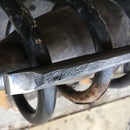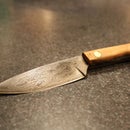Introduction: Make a Beautiful COPPER Holly Leaf Ornament!
This Instructable documents some Christmas presents I made for family members (hence the publishing after Christmas!) These are a great project that can be done with very minimal tooling and with a variety of different approaches. All you need are some basic tools, copper, and some patience! When it's over, you will have a beautiful ornament that anyone will be thrilled to receive. The methods used here can be applied to all sorts of projects and give a great intro into the world of metalworking. I took as many pictures as I remembered, but I didn't initially plan on making this an Instructable so hopefully all the steps are clear!
So, lets get started!
*Note* Most of the work I do revolves around blacksmithing, so I have an assortment of unconventional tools. Don't let this discourage you! I started out doing stuff like this with a super simple setup, and everything here can be done a variety of different ways.
Step 1: Materials and Tools
Materials:
Approximately 24 gauge copper sheet (other metals will work, too). Can be found at the craft store or you can also cut open and flatten a copper pipe.
Metal wire or jump rings
Ribbon
Optional: Spray lacquer
Tools:
Hammer, ball pein OR any hammer with a dapping/doming block set
Tin snips
Chisel(s)
A solid surface -- ideally something like an anvil, but most don't have one. For this sort of work, cheap cast iron anvils such as ones found at Harbor Freight work fine. The back of a vise will work great, as will putting your work on a sledgehammer head or random chunk of steel. Be creative!
A soft block of wood
A Dremel tool with abrasive and buffing attachments (alternatives discussed later)
Optional: A propane torch, a belt sander or buffer
Step 2: Draw Your Template and Transfer Onto the Copper Sheet
The first step is to draw out the holly leaf template (or whatever shape, really). I'll include the template I used, but I encourage you to draw your own!
You can either print out your design and glue it on, trace it onto the metal, or just draw directly onto the metal. I drew it in illustrator and printed it on sticky paper since I didn't want to get spray adhesive on my fingers.
Step 3: Cut Out the Blanks
Use tinsnips (or any other method) to cut out the blanks as closely as possible to the templates.
A couple tips on tinsnips: there are several types, and what you want here are called aviation snips. They're bent-looking, and the funny angle allows you to travel more than a couple inches into a sheet of metal. They are also labeled as left- and right-cutting snips, and this just determines whether the left or right side of what you're cutting gets bent. (The left ones preserve the left side)
Step 4: Refine the Shape
Once the blanks are rough-cut with the snips, refine the shape with a dremel/rotary tool. I used a carbide burr to rough out most of the remaining material and then a small sanding drum to finish the shape and remove the burrs left over (don't forget to remove the burrs, they're sharp!) A set of small files can easily be substituted for the dremel without much added time overall.
Step 5: Optional But Recommended: Anneal the Leaves
A step that will greatly help is to anneal, or soften, the metal. This isn't strictly necessary, but will make the succeeding steps easier and less prone to breaking. Some sheet copper comes annealed, but mine felt a little stiff from the rolling process.
Using the propane torch, heat the copper up until it glows, you don't really want it to get up to orange or hotter--a cherry red color is good. This can be done holding in pliers or on a firebrick like I show. Then, quench the piece in water, after which it will feel super soft. Don't bend it much, because copper work hardens fast and you'll have to anneal it again. There are some lines chiseled in already in the pictures but ignore those til the next step, I just forgot to take pictures first!
(If you're curious: Anneal a scrap piece and bend it back and forth a few times, you'll see how fast it gets harder!)
Step 6: Chisel in the Lines
Now it's time to chisel in the lines. GENTLY tap your chisel with a small hammer, tracing the lines on the template or free handing them. It is preferable to have a chisel that is slightly curved as you see in the picture, as this allows you to rock and curve lines as you're chiseling them in. If you only have a straight chisel you can just make the lines straight, or you can emboss them by bending a needle, taping it onto the leaf, and gently hammering it in. This method is detailed by an awesome author on here named MrBalleng.
It is advisable to practice chiseling in on a scrap piece, because the chisel tends to go in much farther than one might expect.
Step 7: Make Them 3D!
Time to give the leaves their shape! Again, there are lots of ways to do this, but I'll describe my method. Apologies in advance, I didn't take enough pictures here! Hopefully this is clear.
Using a ball-pein hammer (or doming dies), hit a soft piece of wood with the ball side to make a slight depression. Then, flip the leaf over with the lines facing down and gently tap on the back over the depression with the round side of the hammer. This is called sinking. This will make the leave convex when looking at it from the side with the lines.
Then, flip the leaf back over and gently use a (preferably) blunted chisel to tap down the center line. This will make the leaf convex on the sides and concave where the line is, which is more realistic. The picture should make this more clear. Yes, they're a different color, I'll explain that next!
___________________________________
Hammer lingo: The face is the flat side you hit with, the pein is the back side that has a different shape. The pein is shaped based on how you want to move the metal. In the case of a ball pein, the pein is ball-shaped for either making something concave or spreading metal out in all directions.
Step 8: Pickle!
No, not the kind you eat, unfortunately. Eating a pickle is recommended, though, at any given moment during this project.
A pickle in the context of metalworking and jewelry is a corrosive bath that removes oxides from metals. During the annealing step the metal will be very discolored, and the pickle will remove these off-color oxides. What I use is a warm solution of salt and white vinegar, left a few hours or until the oxides are gone. This step is also only necessary if you 1. Annealed them and 2. Want the shiny, coppery finish at the end.
The leaves will look very clean when finished, and will have almost a pink color to them. The pictures show both pickled and un-pickled leaves.
Bonus For anyone interested in metallurgy: I left mine in a little too long, and in the last picture you can actually see the large grain structure of the copper. Metals are made up of lots of tiny grains, each with an even tinier crystalline structure, and the annealing process increases the size of these grains. An acid etch like the pickle brings out the differences between the grains, which makes the grain boundaries visible. Processes like this are actually used to examine the microstructures of metals.
Step 9: Polish, Finish Shaping, and Lacquer the Leaves!
Once you've domed the leaves, use buffing wheels and compound on a rotary tool to polish the leaves. I used green buffing compound which gave a very shiny end result. Just turn on the dremel with a soft wheel, touch it to the waxy buffing compound, and then polish the leaves. If you see black residue you know it's working! This is the tiny particles of metal coming off. The leaf will become shiny and if there is any black residue left it will come off with acetone.
Alternative methods to polishing if you don't have a rotary tool or want them SUPER shiny are to sand with progressively finer grits of sandpaper (up to 1 or 2 thousand grit) and then use buffing compound. Again, I refer you to MrBalleng and his jewelry tutorials.
If you want a patina to develop, stop here. If you want them to stay shiny, use a light coat of nice clear lacquer to protect the leaves.
The final step is to bend the tips of the leaves to make them look realistic. Random is better than looking too regular! Then, bend the stem into a loop and add whatever means of hanging you like. I added a jump ring and some red ribbon/string.
Step 10: You're Done!
Enjoy your new ornament(s)! Make sure to take some glamour shots!
If you enjoyed this, make sure to check out my Instagram, @AntonsenForge! I try to post everything from mini-tutorials to finished products. They're mostly blacksmithing and projects like this, so if that interests you head on over! :)

Runner Up in the
Metal Contest 2017

Runner Up in the
Homemade Gifts Contest 2017

Participated in the
Epilog Challenge 9














